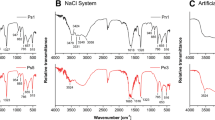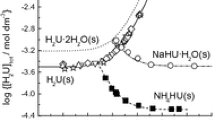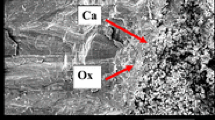Summary.
Calcium oxalate forms three hydrates (stable monoclinic mono-hydrate (COM), metastable tetragonal dihydrate (COD) and triclinic trihydrate (COT)), which are of medical importance in urinary calculi formation. In this work, the solubility of these calcium oxalate hydrates was determined at 20, 25, 30, 37, and 40°C in aqueous NaCl (0.02–0.20 molċdm−3) and in urine-like liquors. Also, for the first time, the solubility of COM was systematically studied as a function of pH in artificial urine solutions which contain organic compounds. The concentrations of calcium ions were measured continuously using a calcium ion selective electrode and also determined by AAS. The thermodynamic solubility products were obtained from computer simulations in which all possible complexes formed in aqueous solution were taken into account. These values were compared to those available in the literature; it was found that the present results, especially for COD and COT, constitute a major improvement on the previously reported values. The constants determined in this work were used to predict the solubility of calcium oxalate hydrates at different pH in urine-like liquors. It was found that in artificial urine solutions, citrate and magnesium ions promote the solubility of COM, whereas urea and creatinine have no significant effect..
Zusammenfassung.
Calciumoxalat bildet das stabile monokline Monohydrat (COM) sowie zwei metastabile Phasen, das tetragonale Dihydrat (COD) und das trikline Trihydrat (COT). Da die drei Calciumoxalathydrate bei der Entstehung von Nierensteinen eine wichtige Rolle spielen, wurde ihre Löslichkeit bei 20, 25, 30, 37, und 40°C in NaCl-Lösungen (0.02–0.20 molċdm−3) sowie in künstlichen Urinlösungen, die zum Teil auch organische Substanzen enthielten, gemessen. In letzteren wurde die Löslichkeit von COM als Funktion des pH-Werts erstmalig systematisch untersucht. Die Ca2+-Konzentrationen wurden mit Hilfe einer ionenselektiven Elektrode sowie durch AAS bestimmt. Die thermodynamischen Löslichkeitsprodukte wurden aus Computersimulationen erhalten, in denen die in der wäßrigen Lösung vorkommenden Komplexe weitestgehend berücksichtigt wurden. Beim Vergleich dieser Größen mit Literaturwerten stellte sich heraus, daß insbesondere die Werte für COD und COT eine wesentliche Verbesserung gegenüber den bisherigen Daten darstellen. Die in dieser Arbeit ermittelten Löslichkeitsprodukte wurden zur Berechnung der Löslichkeit der Calciumoxalathydrate in künstlichem Urin verwendet. Es zeigte sich, daß Mg2+ und Citrat die Löslichkeit erhöhen, wogegen Harnstoff und Creatinin keine signifikante Auswirkung haben..
Similar content being viewed by others
Author information
Authors and Affiliations
Additional information
Received June 19, 1998. Accepted July 20, 1998
Rights and permissions
About this article
Cite this article
Streit, J., Tran-Ho, LC. & Königsberger, E. Solubility of the Three Calcium Oxalate Hydrates in Sodium Chloride Solutionsand Urine-Like Liquors. Monatshefte fuer Chemie 129, 1225–1236 (1998). https://doi.org/10.1007/PL00010134
Published:
Issue Date:
DOI: https://doi.org/10.1007/PL00010134




